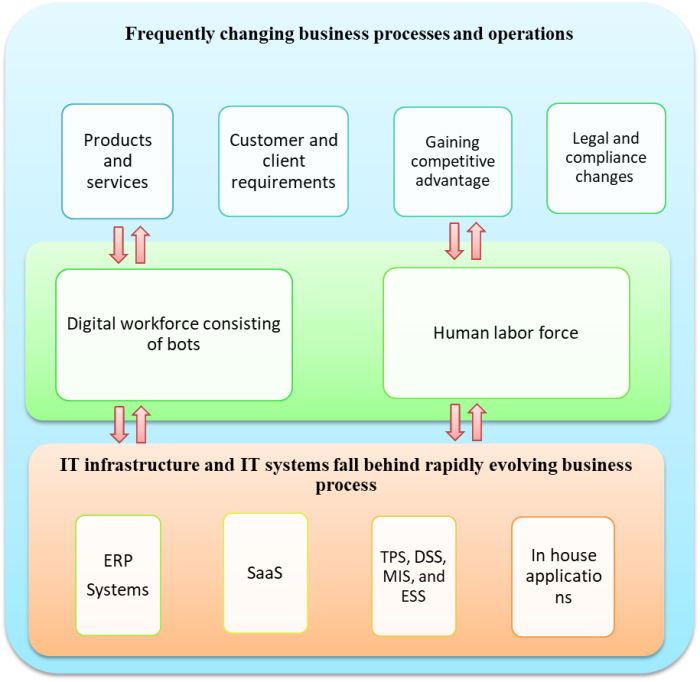Introduction to RPA (Robotic process automation)
What is Robotic process automation (RPA)?
Business enterprises continuously strive to generate more profit by increasing productivity and minimizing costs. Such growth is possible through enhancing business processes through technological innovation that significantly improves efficiency.
Robotic process automation (RPA) is one such innovation that drastically impacts business processes by employing a digital workforce. RPA allows automating tasks with the help of bots to perform most labor-intensive and repetitive tasks such as clerical and back-office work including data entry and data validation.
RPA imitates human actions and can be integrated with an organization's IT system to perform various operations using their in-house application.
Since RPA allows enterprises to use a virtual workforce that can replace manual labor-intensive tasks, which minimizes cost considerably, it is more time-efficient, reliable, and can be easily implemented within the existing infrastructure. RPA does not require administrator-level access to codes or enterprise database and hence is much safer to use.
RPA’s ability to simulate human actions allows it to be used on applications, business processes, software at normal employee level access. This ensures easy implementation of RPA into existing systems to perform any business activity saving a significant amount of time to generate error-free results.
How RPA can help current business enterprises?
Business processes are continuously changing with better improvements, techniques, rules being introduced for simplification, security enhancements, legal requirements, competition, etc. The primary objective to generate more revenue in most companies requires them to evolve their services, products, marketing, and sales that further alter the business process.
This creates a huge problem for organizations as they need to retrain their workforce or hire new employees for every incremental change in the business process. Since employees are hired by organizations to bridge the gap between processes and systems, an ever-changing operation process is a significant barrier to growth.

Another critical factor that limits growth in an organization is that IT systems as a whole require to be updated, maintained, and coded to introduce the new changes. However, business processes change frequently and IT systems and infrastructure up-gradation fall behind due to limitations in budget, time constraints, or complexity in implementation. This creates a significant gap between actual business flow and operational IT systems.
Such discrepancy is rectified using a human workforce that is trained to perform actions based on new updated rules, policies, or requirements. For example, in the case of inventory management, new stocks are ordered when the existing inventory depletes to 25%. However, systems are coded with older information and automated to send restocking requests when the inventory falls below 20%. Countering this issue requires a human intervention who can check inventory levels and order for stock supply as soon as inventory reaches 25%.
However, since business flows and processes change very frequently, companies require to hire new employees or train existing ones which are complex, time-consuming and increases costs. RPA solves this problem by replacing the human workforce with a digital workforce consisting of bots that mimics human action. Every incremental or major change in business flow or operation enterprises require to change in terms of codes and sequences in RPA which is much more cost-efficient and time-saving.
The time and cost efficiency of using RPA can allow the organization to focus on other areas of the company which can considerably strengthen the ability to reach their organization objectives.
Advantages of using RPA
1. Higher productivity and error-free:
RPA has a huge potential in terms of replacing the human workforce to perform labor-intensive, repetitive tasks as well as a complex lengthy process that is systematic and well structured. However, RPA shines in various other aspects as well. RPA employs bots that can work 24 hours a day as compared to humans with limited time frames averaging around 9 hours. Besides, tasks allocated to RPA show significantly higher productivity, close to 100% in comparison to human labor at 60%.
Moreover, bots are more consistent, reliable and almost 100% error-free which is impossible to achieve with a human workforce. Bots can be programmed to perform multiple tasks at once which they can perform at ease with minimal error.
2. Code-free and user-friendly:
Popular RPA implementation tools such as Uipath, Blue prism, etc. require minimal coding experience and are operated using a graphical user interface (GUI). Hence, using RPA is very simple for employees as they can easily perform required activities using pre-defined wizards and workflow sequences.
Moreover, system-level implementation is significantly easier due to a code-free environment as compared to traditional IT automation where coding is an inherent property.
Disadvantages of using RPA
1. Increasing unemployment:
Implementing RPA replaces the human workforce with a digital one that can lead to a significant increase in unemployment. A major number of laborers are employed in an organization to perform clerical, back office, data entry, audit, testing, quality check, and repetitive tasks.
Approximately 20-30% of the entire labor force in the organization consists of such workers. The introduction of RPA will cause such employees to lose their jobs inevitably.
2. The high initial cost of investment:
The initial cost to implement RPA into existing IT systems and processes is considerably huge. Such high investment costs are easily bearable for large enterprises; however, smaller organizations require to consider opportunity costs as their investment budgets are highly rigid.
Despite such high first-time investment costs, long-run benefits are significantly higher to offset the initial drawback. In the long run, RPA implementation leads to a major boost in production, cost reduction, and higher quality of output.

